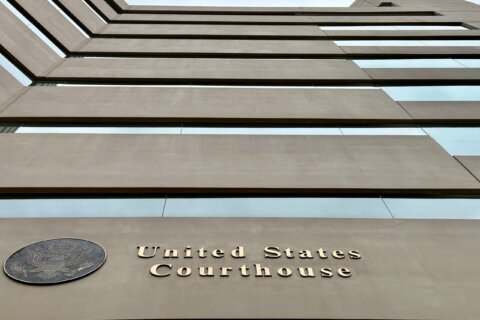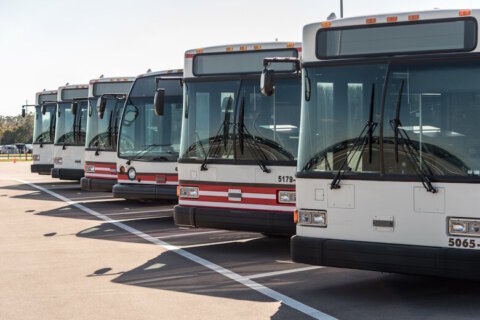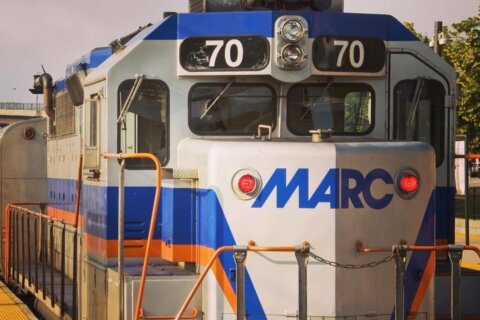This article was republished with permission from WTOP’s news partners at Maryland Matters. Sign up for Maryland Matters’ free email subscription today.
This content was republished with permission from WTOP’s news partners at Maryland Matters. Sign up for Maryland Matters’ free email subscription today.
As he travels the state promoting his second campaign for governor, former Maryland attorney general Douglas F. Gansler (D) does little to hide his disdain for his Democratic primary rivals. The state is facing three major crises, he tells voters — COVID-19, criminal justice, and climate change — and he’s the only candidate with significant experience on the criminal justice and climate fronts.
“It’s going to take them a long time to learn government and how to govern,” he says in an interview.
Never mind that his opponents include the state comptroller, who has held office for 35 consecutive years, and a former Prince George’s County executive and state lawmaker, and two members of President Obama’s cabinet.
Gansler, who turned 59 last month, feels the same way when he hears his foes discussing the existential threat to the planet.
“They know they’re supposed to say something about climate change,” he says. “They know what it means. But they certainly have not waded into that space. It’s a priority for me, for when I’m governor, to make Maryland an East Coast leader in fighting climate change.”
Gansler cannot resist an additional jab: “You don’t find the answers on how to fight climate change in a book.”
As the state’s attorney general from 2007 to 2015, Gansler was an aggressive litigator against polluters. He prioritized enforcing state environmental regulations, and came to every General Assembly session armed with a new proposal for environmental legislation. He convened an environmental council within the attorney general’s office, which his successor, Brian E. Frosh (D), retains to this day, and conducted almost two dozen audits on the health of Maryland’s rivers.
As an attorney in private practice since he left office following his first unsuccessful run for governor, Gansler has advised cities and states on how to sue the fossil fuel industry for environmental damages. Just as significant, Gansler prides himself on being ahead of the curve when it comes to discussing the imperative of meeting the state’s climate challenges and putting the issue before voters and fellow policymakers.
“It used to be something only groovy lefties used to talk about,” he observes. “Now it’s part of the mainstream dialogue.”
Gansler is an ebullient campaigner, an easygoing jokester who will weigh in on any subject, whether he’s asked to or not. Sometimes such impudence can get him in trouble. But it’s hard to deny his commitment to the environment and associated causes, and it’s clear he’s thought about how to use the tools of government to make Maryland a cleaner place — and less vulnerable to the ravages of a warming planet.
Earlier this fall, Gansler released an ambitious 32-point plan for combating climate change in the state — a sign, he says, of how bleak the situation is and how all-encompassing the approach must be. But it also buttresses his belief that “there’s not a panacea, one silver bullet, to fight back against climate change.”
Gansler proposes a wide range of remedies, from converting the state government’s vehicle fleet from fuel-powered to electric within five years, to converting poultry waste into renewable energy, to increasing funding for schools that are heated and cooled by geothermal energy. Like most Democratic candidates, he says he’d make sure the state is doing more to promote renewable energy industries, boost mass transit, and work with regional partners to address Chesapeake Bay degradation.
But many of his proposals make it sound as if he’s running for state planning secretary rather than governor, or perhaps for a job on a suburban county council. Several of Gansler’s recommendations deal with zoning and land use, including a proposed five-year statewide moratorium on new residential, commercial and industrial development in certain areas near the Bay, and establishing a “scoring” system to ensure that state funds for neighborhood revitalization are being applied toward projects that meet Smart Growth goals.
Gansler is unapologetic about the elements of his proposal. “It’s comprehensive because it needs to be,” he says.
Gansler dismisses the environmental and climate record of the man he hopes to replace, Gov. Lawrence J. Hogan Jr. (R), saying “there isn’t much of a performance to assess. I don’t think that’s a priority for him.”
And while he expresses admiration for the all-encompassing approach President Biden is taking on climate change — including installing special envoys, former U.S. Environmental Protection Agency Administrator Gina McCarthy and former Secretary of State John F. Kerry, to lead the domestic and international efforts, respectively — he does not believe state government requires a “czar” to oversee all its climate work, as long as the governor is sufficiently committed to the cause.
“I think you need a czar if the commitment and principle to fighting climate change is not seeped into the very fabric of state government,” Gansler says. “I think what you need to do is hire an environmentalist to run the Maryland Department of the Environment. …You get competent, good people.”
Banking on ‘an enormous influx of capital from the federal government’
Gansler is limited by what he can say about Hogan’s proposal to widen the American Legion Bridge and portions of the Capital Beltway and Interstate 270, because he’s suing Maryland on behalf of one of the losing bidders for the state contract. But he describes the bridge widening piece of the proposal as vital, and expresses some skepticism about all the rest.
Asked where he thinks the project will be when the next governor takes office in January 2023, Gansler replies: “It’s Montgomery County and it’s Maryland. Until the pavement comes out of the truck, it’s not really a done deal.” And asked how he feels about Hogan’s argument that getting cars moving that are currently stuck idling in traffic will reduce air pollution, Gansler, uncharacteristically, says he doesn’t know.
Without discussing specifics, Gansler is sharply critical of the state’s procurement process and asserts that while the public-private partnership concept for paying for major infrastructure projects can work, the programs haven’t been successful in Maryland.
“If people knew how incompetent it was, there would be a revolution,” he says.
Gansler regularly promotes mass transit on the campaign trail — including some version of the Red Line in Baltimore that Hogan scrapped, reviving the proposal to run light rail (or possibly a monorail) along Interstate 270 in Montgomery and Frederick counties, and building a transit line from the Branch Avenue Metro station in Prince George’s County to Southern Maryland.
While transportation funding in Maryland largely comes from the state gasoline tax, which was last raised in the final years of former Gov. Martin J. O’Malley’s administration, Gansler argues that legalizing recreational cannabis — he’s an early endorser of that reform — and enacting sports gaming can help pay for some of the major projects.
He also notes that “an enormous influx of capital from the federal government” is headed the state’s way, thanks to the recently passed infrastructure package in Congress.
Gansler argues that robust transit ridership is attainable, and that more riders translate to more funding for various transit proposals. He points to the San Francisco Bay area, where tech professionals are ferried to work on sleek, company-owned buses, equipped with WiFi and other amenities, as a possible model for Maryland.
“Some of these projects are just calling out to be built,” he says. Then he takes a swing at another candidate for governor, Comptroller Peter V.R. Franchot (D), who has said his first task as governor would be ensuring that potholes are filled on every Maryland road.
“There’s more jobs associated with building mass transit than there are in filling potholes,” Gansler says.
Clean energy advocates also see a developing renewable energy industry as key to growing Maryland’s economy and creating more jobs, and Gansler is no exception. He calls developing offshore wind projects “a no-brainer,” and his climate plans calls for extensive installation of rooftop solar panels, among other measures to boost the industry.
Some long-term proposals for meeting clean energy mandates in Maryland rely on natural gas as a “bridge fuel,” and maintain the state’s reliance on nuclear power, which currently supplies about 80% of the carbon-free energy that’s produced in the state. Gansler is emphatic in his opposition to natural gas proliferation, but is less sure about nuclear.
“Natural gas is still a pollutant,” he says. “It’s problematic. It’s better than coal-burning power plants. Nuclear is really interesting. Nuclear energy is as clean as it gets, it works, it’s powerful, it’s a great source of clean energy. But there are dangers associated with it. And when it goes south, it really goes south.”
Asked what he would do if Exelon, the operator of the Calvert Cliffs nuclear plant in Lusby, comes to the state seeking clean energy subsidies, the way it has in Illinois, Gansler says, “I’m always willing to listen.”
Gansler’s personal climate hero is…
Asked to name his personal climate hero — a question Maryland Matters asked of all the Democratic contenders — Gansler offers two: the late U.S. Sen. Joseph Tydings (D-Md.) and former Gov. Parris N. Glendening (D).
When Gansler was attorney general, Tydings became the chair of his environmental council, and Tydings also introduced Gansler to Southern Maryland politicians who were monitoring the health of the Chesapeake Bay in a homespun way. He recalls wading into the Chesapeake Bay with the local leaders to see how clear the water was — another ritual of Maryland politics that he’s convinced his primary opponents know nothing about.
“I was looking at my toes [in the water],” Gansler says. “I’m running against eight people who don’t even know what that means.”
Gansler says Glendening, who served from 1995 to 2003, should be the model for any Maryland governor when it comes to environmental policy: “He was way ahead of his time.”
Even after disparaging his opponents, Gansler concedes that the debate in the state over climate change is about to change for the better, as long as a Democrat — any Democrat — is elected governor.
“We haven’t had a Democratic governor with a Democrat legislature since climate change got into the public lexicon,” he says.
And whomever is governor is going to have a big influence on what the debate over climate policy looks like and the challenge of convincing Marylanders to take it seriously, Gansler maintains.
“The problem is, people wake up, the sky is blue and the water’s clean. Then people start thinking about how to put food on the table,” he says. “I do think that attitudes are changing slowly — too slowly, but relatively quickly, that people understand that this is real, that this is an existential crisis.”







